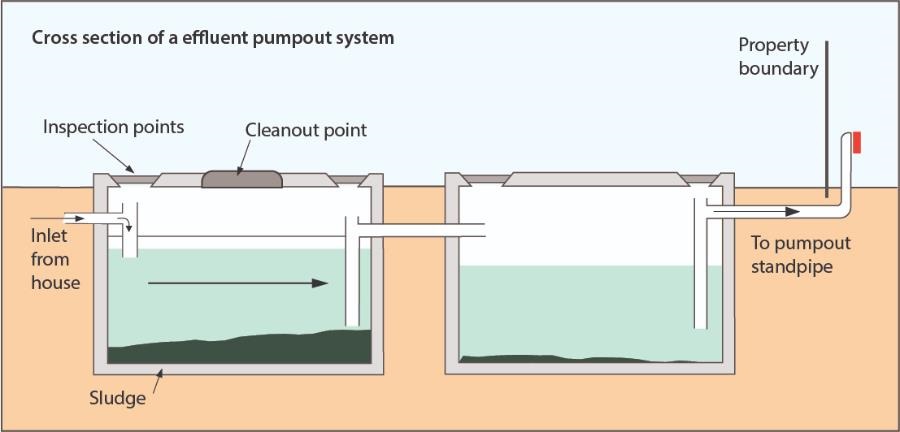An effluent pumpout service is conducted to a premises that have a contained onsite wastewater collection system. The system generally consists of two tanks, a septic tank and a collection tank. The effluent is removed from the tank from the standpipe at the property boundary. A regular pumpout is required to manage the system and prevent overflowing.
Here is a cross-section of how an effluent tank looks inside.

It is the owner's responsibility to ensure a correct pumpout schedule is selected and this can be determined by how much water you use and the size of the tank.
A clean out of the septic tank is recommended approximately every 5 years to remove any solid settlement buildup on the bottom of the tank. Cleanouts are a prepaid service and can be requested via our online Septic Tank Cleanout Form.
What happens at a pumpout
We use a contractor to conduct the service on your effluent system. To avoid delays we suggest you maintain the components of the system including:
Standpipe access - To allow the road tanker to pump out the system, a standpipe is located at the boundary of the property; this is where the tanker connects to your system. Remove any obstacles or obstructions to the standpipe for easy access. Not providing clear access to the standpipe can prevent the pumpout service from being completed.
Standpipe cap - The orange cap helps to easily identify the location of the standpipe. If it starts to fade, falls off and gets lost, or if it breaks, it can easily be replaced from an electrical wholesaler who refer to them as a conduit cap or plug.
Standpipe and pusher pumps should be inspected by the owner before the service to ensure that the standpipe does not suck air or to ensure the pusher pump is not faulty. If your standpipe sucks air or your pusher pump is faulty the contractor will advise you via your docket left at your property and Shoalhaven Water will notify you via a letter or email. It is the owner's responsibility to have the problem rectified within twenty-eight (28) days. Note: if no action taken Council cannot accept responsibility for effective effluent removal services at your premises.
Service dockets - At the completion of a pumpout, our contractor will leave a docket in the letter box showing the total amount of effluent removed (in litres), and the readings on the gauges before and after the pump out (to the nearest 100 litres). If a letter box is not available, it is a good idea to leave a tin or box near the service pipe where dockets can be safely stored.
Customers can confirm the volume extracted by reading the sight gauges attached to each tank and comparing the levels against the docket. Alternatively, you can make an arrangement to attend a service.
At any time, you can check the volume of effluent within the tank by lifting the inspection lid or by using the 'dip stick' on top of the tank.
Excessive rain periods
Rainwater may infiltrate tanks causing an increase of wastewater in the collection well.
If cracks in the lid are noticed, it is important to get them fixed to maintain the watertight integrity of the system.